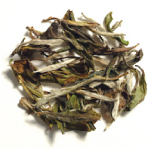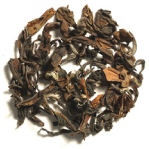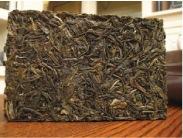the main tea varieties
White, Green, Oolong, Black, Pu Erh teas all come from the same plant: the Camellia Sinensis. The way the leaves are processed is what determines the resulting color of the tealeaves and their classification. The biggest difference is made by the fermentation or oxidization process (a chemical reaction produced by the enzymes contained in the fresh leaves) that differentiates white and green teas from black, Oolong, and Pu Erh teas.
Please note that even though the following classification method is considered standard in most parts of the world, there is also a specific Chinese method which classifies teas according to the color reflexes of the infused liquid. This can mean, for example, that what is generally considered a green tea in the "standard" western classification, could very well fall under the Black tea class according to the Chinese classification.
white tea
 White teas are the ones that remain closer to the natural state of the tealeaf. The processes undergone by the leaves are just two: withering and drying. The young leafs from the spring flush are picked (usually in April) and left to wither in the open air for a long period of time (up to 60 hours) after which they are dried in pans for around half an hour. The resulting production is the most delicate and the most expensive: only the buds and the first leaf are used.
White teas are the ones that remain closer to the natural state of the tealeaf. The processes undergone by the leaves are just two: withering and drying. The young leafs from the spring flush are picked (usually in April) and left to wither in the open air for a long period of time (up to 60 hours) after which they are dried in pans for around half an hour. The resulting production is the most delicate and the most expensive: only the buds and the first leaf are used.
White tea is a specialty born in the Fujian region of China, although today there are excellent productions in the Yunnan region, as well as in Sri Lanka and India.
In the Yunnan region of China white teas are sometimes used to make artistic teas. Special white tea is shaped by hand in various forms: blooming teas for example are often shaped like a sphere with a flower inside that blossoms during infusion. Other shapes are reminiscent of Chinese mythology, like the calabash symbolizing the womb of fertility, or the Jasmine dragon pearls representing the 7 pearls hidden by each dragon that will bring good fortune to whomever will find them all. There are hundreds of different shapes that add beauty and tradition to the infusion.
green tea
 Just like white teas, green teas are also non-fermented, but unlike white teas the processing involves 4 steps: withering, heating, rolling and drying.
Just like white teas, green teas are also non-fermented, but unlike white teas the processing involves 4 steps: withering, heating, rolling and drying.
After the leaves are shortly withered, they are heated at a temperature of 100° for a few minutes; this process can be carried out either in large pans (in China) or through steam cooking (in Japan). This process softens the leaves and makes it easy to roll them, either while they are still hot or when they cool down.
They can now be shaped in many different forms, the most common being flat, twirled, or round.
The drying process consists in making hot air circulate around the leaves repeatedly until the content of moisture is around 5%.
oolong tea
 In Oolong tea (or Wu Long, meaning Black Dragon) the fermentation is stopped half way trough and the result is a tea that stands in between green tea and black tea.
In Oolong tea (or Wu Long, meaning Black Dragon) the fermentation is stopped half way trough and the result is a tea that stands in between green tea and black tea.
This type of tea is produced mainly in China (in Fujian) and in Taiwan. In China Oolong is generally lightly fermented and the process is stopped at 10-15% of the way, which makes them more similar to green teas.
In Taiwan the fermentation goes on till about 60-70%, which gives the tea a darker tone.
he leaves are first withered and then they are placed in a humid room with a temperature of around 25° to start the fermentation process. The leaves are stirred continuously so that the aroma is easily released. The duration of this process depends on the degree of fermentation wanted by the producer; it varies from 10% to 70%.
When the desired degree of fermentation is achieved, the leaves are dried to halt the reaction.
black tea
 Black teas are probably the result of the necessity to transport tea during long journeys to Europe and store them for longer periods of time. In black teas the fermentation process is completed.
Black teas are probably the result of the necessity to transport tea during long journeys to Europe and store them for longer periods of time. In black teas the fermentation process is completed.
The leaves are first withered and then rolled. The objective of rolling black tea is different from green tea because the aim is not to give it a shape but to break the structure of the leaf facilitating the enzyme reaction.
The next step is the fermentation that is carried out for approximately 3 hours depending on the leaves and the tradition of the region. This process also gives the leaves their colour and their distinctive liquor.
pu erh tea
This type of tea differs from black teas and can therefore be considered a separate category, since it undergoes a totally different fermentation process. After been withered, the leaves are heated at very high temperatures (around 300°C) to kill the enzymes. The leaves are then steamed and rolled and put inside cloth bags to be gently "massaged".
At this point the so-called post-fermentation caused by bacteria begins, a process that is usually repeated several times. To withstand this traumatic processing normally the older, the more robust 4th and 5th leaves are used. Traditionally, more robust leaves from wild plants native to Yunnan called "large leaf" were used.
 At the end of the process, Pu Erh tea is often compressed in different forms (briquettes, balls, bird nests). The resulting tea can be stored for very long periods of time, and is the only tea that can increase in complexity and value with the passing of time.
At the end of the process, Pu Erh tea is often compressed in different forms (briquettes, balls, bird nests). The resulting tea can be stored for very long periods of time, and is the only tea that can increase in complexity and value with the passing of time.
The taste is very strong and peculiar, reminiscent of wet turf, which is quite normal considering that traditionally it is stored underground and, as with all teas, it absorbs the scent of its surroundings.
Lately Pu Erh tea has become very popular in western countries for its reported health benefits, and its low level of caffeine.